|

 Up
Up 
 1899 Wright Kite
1899 Wright Kite

(You are here.)



  Need
to Need
to
find your
bearings?
Try
these
navigation aids:
If
this is your first
visit, please stop by:
Something
to share?
Please:



|
|
Available in Française, Español, Português, Deutsch, Россию,
中文,
日本, and others.
 his
was Wilbur's first recorded experiment in aeronautics, flying a
biplane kite to investigate whether or not an aircraft could be
rolled around its longitudinal axis by twisting the wings. Later,
Orville described the kite as a model glider: "This model consisted of superposed planes [i.e., a
biplane] measuring five feet from tip to tip and about thirteen inches from front to rear.
The model was built and, as I remember it, was tested in the latter part of July, 1899....
I was not myself present." his
was Wilbur's first recorded experiment in aeronautics, flying a
biplane kite to investigate whether or not an aircraft could be
rolled around its longitudinal axis by twisting the wings. Later,
Orville described the kite as a model glider: "This model consisted of superposed planes [i.e., a
biplane] measuring five feet from tip to tip and about thirteen inches from front to rear.
The model was built and, as I remember it, was tested in the latter part of July, 1899....
I was not myself present."
Orville may have been mistaken about the kite measurements; in
his first letter to
Octave Chanute (13 May 1900), Wilbur describes the kite: "My
experiments hitherto with this apparatus have been confined to
machines spreading about 15 square feet on surface..." Wilbur had
studied Chanute's 1896 biplane glider and indicated that his kite
was built along the same lines. Chanute used an aspect (wingspan to
chord) ratio of 4:1, as did Wilbur when he later built the 1900
Wright glider. It's likely that Wilbur used this same aspect
ratio for the 1899 kite, giving it a wingspan of 72 inches and
a chord of 18 inches.
The 1899 Wright Kite specifications:
- 6 ft (1.8 m) wingspan
- 1.5 ft (46 cm) chord
- Camber unknown
- Separation unknown; probably 1.5 ft (46 cm)
- Rear elevator, size unknown
- Length unknown, probably 3 to 4 ft (91 to 122 cm)
- Weight unknown, probably 3 to 4 lbs (1.4 to 1.8 kg)
Whatever its dimensions, this was a steerable kite
with four control lines attached to the front corners of the biplane
assembly. These lines were attached to two sticks. When Wilbur
angled the sticks in opposite directions, the wings moved like a
scissors (as viewed from the top). This movement twisted the wings
of the kite, turning one set of wingtips up and the other set down.
This in turn caused the kite to roll, proving that a manned aircraft
could be rolled in the same manner.
The brothers originally referred to this as wing twisting, but
Chanute later dubbed it "wing warping" and the name stuck.
Orville took credit for the idea of wing warping, but credited Wilbur with inventing the
mechanism by which the wings were warped. Apparently the idea
occurred to Wilbur while twisting a cardboard box. The Wrights used this same
"scissors action" helicoidal wing warping on three full sized
gliders built between 1900 and 1902, and continued to use a modified
version on their powered aircraft.
After concluding his kite experiment, Wilbur hung the kite in the bicycle shop and scavenged pieces for other projects. In 1905,
the brothers burned its remains with other trash.
See more images of the 1899 Wright Kite in our
Virtual Hangar.
References:
- Wright, Orville, "How We Invented the Airplane." (from depositions in
Montgomery vs. U.S. 13 Jan 1920 and 2 Feb 1921; in Kelly, Fred C. (editor) How We Invented the
Airplane, an Illustrated History. Dover Publications, New York, 1953, p 12-13).
- Kelly, Fred C. The Wright Brothers, a Biography. Harcourt, Brace and Co., New York,
1943, p 49.
- McFarland, Marvin W. (ed) The papers of Wilbur and Orville Wright. McGraw-Hill Book Co.,
New York, 1953, pp 8-12, 1183; Orville's illustrations of the 1899 Kite are on pages 9-10.
[Submitted by Joe W. McDaniel]
|
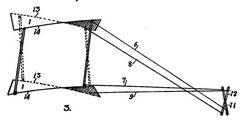
Wilbur built this kite in 1899 to test whether warping the wings would roll the
craft right and left. The kite was controlled from the ground by four cables attached to
two sticks.
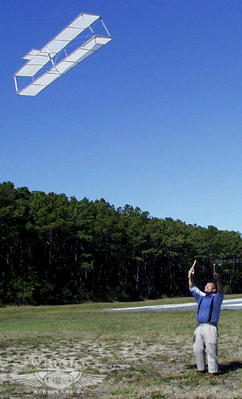
Flying a replica of the 1899 Wright Kite.
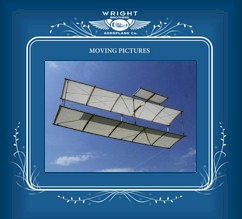
Click the image above to see a short video of the 1899 Wright Kite
in flight.
|
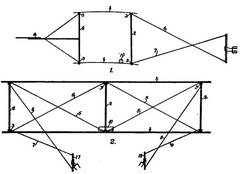
The kite had a small horizontal tail attached to back middle strut. This was
the last flying machine built by the Wrights to have a horizontal tail in the back until
over a decade later, when the Wright Company began to manufacture the Wright Model B airplane.
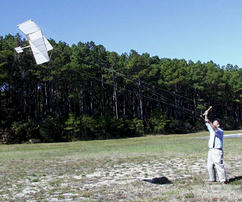
Rolling the kite. Note how the wings move with a scissors action –
the top wing has moved clockwise (as viewed from the top) while the
bottom wing has moved counterclockwise. This action imparts a
helicoidal twist to the flexible wings, turning one set of wingtips
up in the airstream and the other set down.
|